2012中学英语教学法第一次导学课PPT
- 格式:ppt
- 大小:215.50 KB
- 文档页数:50
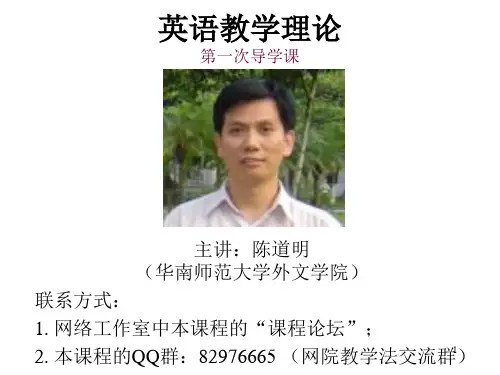
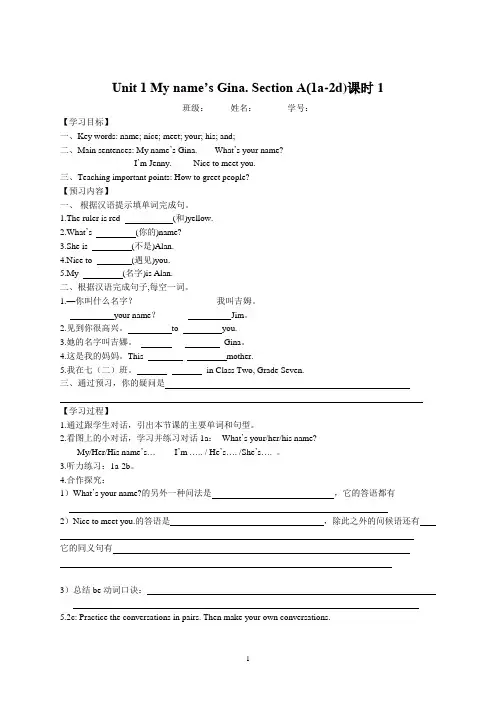
Unit 1 My name’s Gina. Section A(1a-2d)课时1班级:姓名:学号:【学习目标】一、Key words: name; nice; meet; your; his; and;二、Main sentences: My name’s Gina. What’s your name?I’m Jenny. Nice to meet you.三、Teaching important points: How to greet people?【预习内容】一、根据汉语提示填单词完成句。
1.The ruler is red (和)yellow.2.What’s (你的)name?3.She is (不是)Alan.4.Nice to (遇见)you.5.My (名字)is Alan.二、根据汉语完成句子,每空一词。
1.—你叫什么名字?--我叫吉姆。
-- your name?-- Jim。
2.见到你很高兴。
to you.3.她的名字叫吉娜。
Gina。
4.这是我的妈妈。
This mother.5.我在七(二)班。
in Class Two, Grade Seven.三、通过预习,你的疑问是【学习过程】1.通过跟学生对话,引出本节课的主要单词和句型。
2.看图上的小对话,学习并练习对话1a:- What’s your/her/his name?-My/Her/His name’s…--I’m ….. / He’s…. /She’s…. 。
3.听力练习:1a-2b。
4.合作探究:1)What’s your name?的另外一种问法是,它的答语都有2)Nice to meet you.的答语是,除此之外的问候语还有它的同义句有3)总结be动词口诀:5.2c: Practice the conversations in pairs. Then make your own conversations.【课堂作业】一、用am, is, are将下列句子填补完整。


---------------------------------------------------------------最新资料推荐------------------------------------------------------ 中学英语教学法第二次导学课4 中学英语教学法第二次导学课主讲:陈道明(华南师范大学外文学院)chendm@1/ 55学习建议1. 要利用网络课件学习; 2. 要在线听“导学课”(共四次),或通过学习中心下导学课的录像(也可以在我给你们开的公共邮箱gdchendm@下载) ,重看录像; 3. 在BBS(交流园地)的“资源区”上下载“导学课”的 PPT ,复习PPT上的内容; 4. 学习《英语教学法教程》的相关章节; 5. 在BBS上下载“自测题”,解压,做题。
理解题目的意思;6. 经常访问BBS,提出问题,参与讨论; 7. 按时完成网上作业。
---------------------------------------------------------------最新资料推荐------------------------------------------------------ 第二次导学课内容? Task-based Language Teaching ? Teaching Pronunciation ? Teaching Grammar ? Teaching Vocabulary3/ 55Task-based Language Teaching (TBLT)---------------------------------------------------------------最新资料推荐------------------------------------------------------ Approach and MethodApproachMethod 1 Method 2 Method X5/ 55Communicative ApproachCLTTBLT/TBL---------------------------------------------------------------最新资料推荐------------------------------------------------------ What is a “task”?According to M. H. Long (1985:89): A task is “ a piece of work for oneself or forothers, freely or for some reward.” e.g. painting a fence; dressing a child; filling outa form; buying a pair of shoes; making an airline reservation; borrowing a library book; taking a driving test; typing a letter; weighing a patient; sorting letters; taking a hotel reservation; writing a cheque; finding a street destination; helping someone across a road; etc.7/ 55Pedagogical tasks def ined by David Nunan (1989: 8) :… a piece of classroom work which involves learners in comprehending, manipulating, producing or interacting in the target language while their attention is principally focused on meaning rather than form.---------------------------------------------------------------最新资料推荐------------------------------------------------------ Will, J. (1996: 23)? Tasks are activities where the target language is used by the learner for a communicative purpose (goal) in order to achieve an outcome.9/ 55Clark, Scarino and Brownell (1994:40):Four main components of a task? A purpose: a reason for undertaking the task.? A context: can be real simulated or imaginary (location, participants, time, etc.)? A process: to use learning strategies (problem solving, reasoning, inquiring, conceptualising, communicating, etc.)? A product: some form of outcome, visible (a written plan, a play, a letter, etc.) or invisible (enjoying a story, learning about another country, etc.)---------------------------------------------------------------最新资料推荐------------------------------------------------------ Exercises, exercise-tasks, and tasks? Tasks: focusing on the complete act of communication.? Exercises: focusing on individual aspects of language, such as vocabulary, grammar or individual skills.? Exercise-tasks: halfway between tasks and exercises.11/ 55A taskA dangerous momentStudent AHave you ever been in a situation where you felt you life was in danger? Describe the situation to your partner. Tell him/her what happened. Give an account of how you felt when you were in danger and afterwards.Student BListen to your partner’s narration about a dangerous moment in his/her life. Draw a picture to show what happened to your partner. Show him/her your picture when you have finished it.---------------------------------------------------------------最新资料推荐------------------------------------------------------ An exerciseGoing shoppingLook at Mary’s shopping list. Then look at the list of items in Abdullah’s store.Mary’s shopping list1. oranges 2. eggs 3. flour 4. powdered milk5. biscuits6. jamAbdullah’s store1. bread 2. salt 3. apples 4. Coca Cola5. tins of fish 6. four 7. chocolate 8. sugar9. curry powder 10. biscuits 11. powdered milk 12. dried beansWork with a partner. One person be Mary and the other be Abdullah. Make conversations like this:Mary: Good morning. Do you have any flour?Abdullah: Yes, I do.OrMary: Good morning. Do you have any jam?Abdullah: No, I’m sorry. I don’t have any.13/ 55PPP and TBLT---------------------------------------------------------------最新资料推荐------------------------------------------------------ Jane Willis’ (1996) TBL frameworkTask cycleLanguage focus15/ 55---------------------------------------------------------------最新资料推荐------------------------------------------------------ Task cycleTaskPlanningReportSs do the task, in pairs or smallgroups.T monitors from a distance.Ss prepare to report to the whole class (orally or in writing) how they did thetask, what they decided or discovered.Some groups present their reports to the class, or exchange written reports, and compare results.Ss may now hear a recording of others doing a similar task and compare how they all did it.17/ 55Language focusAnalysisSs examine and discussspecific features of thetext or transcript of the recording.AnalysissT conducts practice of new words, phrasesand patterns occurring in thedata, either during or afterthe analysis.---------------------------------------------------------------最新资料推荐------------------------------------------------------ Task cycleTask Planning ReportSs hear task recording or read textLanguage focusAnalysis & practice: Review & repeat task.PPP Presentation of single ‘new’ itemPractice of new item: drills exercises, dialogue practiceProduction Activity, role play or task to encourage ‘free’ use of L.19/ 55Teaching Pronunciation (Unit 6)? Components of pronunciation ? The goal of teaching pronunciation ? Practising pronunciation---------------------------------------------------------------最新资料推荐------------------------------------------------------ Components of pronunciation1. Simple sounds 2. Stress 3. Intonation 4. Rhythm21/ 55What should we teach whenteaching pronunciation?? We should pay attention to the distinction between pronunciation and phonetics.? The teaching of pronunciation should focus on the students’ability to identify and produce English sounds themselves. Students should NOT be led to focus on reading and writing phonetic transcripts of words, especially young students.? Introduction to phonetic rules should be avoided at the beginning stage.? Stress and intonation should be taught from the very beginning.---------------------------------------------------------------最新资料推荐------------------------------------------------------ The goal of teaching pronunciationThe realistic goals: 1. Consistency: Be smooth and natural.(连贯性)(fluency) 2. Intelligibility: Be understandable.(可辨认性,可理解性) 3. Communicative efficiency: Convey themeaning that is intended.(交际的有效性)23/ 55Practising pronunciation? Mechanical practice and Meaningful practice? Perception practice and Production practice---------------------------------------------------------------最新资料推荐------------------------------------------------------ Mechanical practice? Pronunciation is difficult to teach without drills on sounds.? However, drilling an individual sound for more than a few minutes a time may be boring and demotivating.? Sometimes we can make mechanical practice, i.e. drilling, more interesting and motivating, e.g. by playing games.25/ 55Meaningful practice? It is important to combine drilling pronunciation exercises with more meaningful exercises. e.g.1. A polliwog looks for his mom.2. A card game: What can you see?---------------------------------------------------------------最新资料推荐------------------------------------------------------ Perception practiceAim: to develop the ability to identify and distinguish between different soundsWays of perception practice: ? Using minimal pairs: will, well; till, tell; fill, fell ? Which order? 1. bear 2. tear 3. ear ? Same or different? met, meet; well, well; well, will ? Odd man out: bit, bit, bit, pit ? Completion: ate, ate, ate, ate, ate, …27/ 55Production practiceAim: to develop the ability to produce soundsWays of production practice:? Listen and repeat.? Fill in the blanks by saying words containing certain sounds. (p.55)? Make up sentences. e.g. last, fast, calm, dark…? Use meaningful context, e.g. role play the dialogue? Use pictures. (p.56) This is old Jack. He has a black cat…? Use tong ue twisters. (p.56) She sells seashells on the seashore. Five wives drank five bottles of fine wine.---------------------------------------------------------------最新资料推荐------------------------------------------------------ Some essentials of teaching pronunciation? Create a pleasant, relaxed, and dynamic classroom.? Use gestures. ? Build-up Students’ confidence. ? Bring variety to the classroom, e.g. Br. &Am. ? Use demo rather than explanation. ? Use visual aids.29/ 55Teaching Grammar (Unit 7)? Grammar presentation methods? Grammar practice---------------------------------------------------------------最新资料推荐------------------------------------------------------ Grammar presentation methods? The deductive method ? The inductive method31/ 55The deductive method? The deductive method relies on reasoning, analysing and comparing.The deductive method is criticized because:? Grammar is taught in an isolated way; ? Little attention is paid to meaning; ? The practice is often mechanical.---------------------------------------------------------------最新资料推荐------------------------------------------------------ Merits of the deductive method? It could be very successful with selected and motivated students.? It could save time when students are confronted with a grammar rule which is complex but which has to be learned.? It may help to increase student’confidence in those examinations which are written with accuracy as the main criterion of success.33/ 55The inductive method? In the inductive method, the teacher induces the learners to realise grammar rules without any form of explicit explanation.? It is believed that the rules will become evident if the students are given enough appropriate examples.? It is believed that the inductive method is more effective in that(=because) students discover the grammar rules themselves while engaged in language use.---------------------------------------------------------------最新资料推荐------------------------------------------------------ Distinction between Deduction and Induction ingrammar teaching? Deductive teaching ? Inductive teachinge.g.e.g.e.g.Rulee.g.e.g.Rulee.g.e.g. e.g.35/ 55Usually no clear-cut distinction? In practice, the distinction between the deductive method and the inductive method is not always apparent.---------------------------------------------------------------最新资料推荐------------------------------------------------------ Grammar practiceAccording to Ur, 6 factors contribute to successful practice.37/ 55According to Ur, 6 factorscontribute to successful practice? Pre-learning.(预习) Learners benefit from clear perception and short-term memory of the new language.? Volume and repetition. (反复复习)The more exposure to or production of language the learners have, the more likely they are to learn.? Success-orientation. (成功感)Practice is most effective when based on successful practice.? Heterogeneity. (水平要求的多样性)Practice should be able to elicit different sentences and generate different levels of answers from different learners.? Teacher assistance. (教师的辅助)The teacher should provide suggestions, hints and prompts.? Interest : (趣味性)an essential feature that is closely related to concentration---------------------------------------------------------------最新资料推荐------------------------------------------------------ Grammar practice? Mechanical practice ? Meaningful practice39/ 55Mechanical practiceMechanical practice involves activities that are aimed at form accuracy.e.g. ? Substitution, and ? Transformation drills---------------------------------------------------------------最新资料推荐------------------------------------------------------ Meaningful practice? In meaningful practice the focus is on the production, comprehension or exchange of meaning, though the students “keep an eye on” the way newly learned structures are used in the process.? e.g.:41/ 55Pair work: Look at the table below. Rank the itemson the left column according to the criteria listed on the top.Cheap Healthy Tasty Fattening ImportantBeer Water FruitCigarettesAlcohol Milk---------------------------------------------------------------最新资料推荐------------------------------------------------------ There is no clear-cut distinction between mechanical practice and meaningful practice.e.g. Chain of events? If I went for a sail, there might be a storm.? If there were a storm, my yacht would sink.? If my yacht sank, I would die. ? If I died, my parents would cry. ?…43/ 55Some forms of meaningful practice? Using prompts for practice–Picture, mime or gestures, information sheets, key phrase or key words, chained phrases for story telling? Using created situations: for simulative communication (role-play). e.g.–Your are a stranger in this town. … – There was a robbery yesterday in theneighbourhood. …---------------------------------------------------------------最新资料推荐------------------------------------------------------ Some suggestions about teaching grammar1. Teach only those rules that are simple and typical.2. Teach useful and important grammar points. 3. Teach grammar in context. 4. Use visible instruments such as charts,tables, diagrams, maps, drawings, and realia (pl. of realis) to aid understanding; 5. Avoid difficult grammatical terminologies as much as possible. 6. Allow enough opportunities for practice. 7. Live with the students’ mistakes and errors.45/ 55Teaching Vocabulary (Unit 8)? Presenting new words ? Consolidating vocabulary ? Developing vocabulary buildingstrategies---------------------------------------------------------------最新资料推荐------------------------------------------------------ Presenting new wordsSome suggestions: ? Provide creative examples. ? Elicit meaning from the students before tellingthem. ? Use related words such as synonyms, antonymsetc. to show the meaning. ? Think about how to check students’understanding. ? Relate the new word(s) to real life context(s). ? Predict possible misunderstanding or confusion.47/ 55Some more suggested ways? Use pictures, diagrams and maps to show the meaning;? Use realia (plural of realis); ? Use pantomimes or actions; ? Use lexical sets;e.g. cook, fry, boil, bake, grill, roast ? Translate and exemplify, esp. with technicalor abstract words; ? Use word formation rules and common affixes.e.g. deduction, induction---------------------------------------------------------------最新资料推荐------------------------------------------------------ How do we teach the new words, e.g., 20 new words, in a unit of atextbook?? Do we teach all the 20 word at a time in an isolated way, i.e., without context? or:? Do we use context and allow the new words to occur in a natural way?49/ 55A possible way? Before reading the text: T: We are going to read a story about NelsonMandela, the first black president of South Africa. Which of the following words do you think may be used in the story? prison, rights, violence, lawyer, youth, league, position, matter, fact, president; vote, accept; continue black, equal, poor, young, wrong, worried Make a guess.。
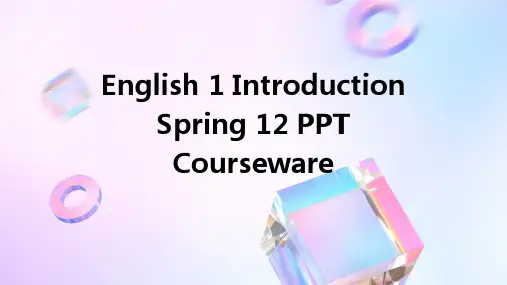
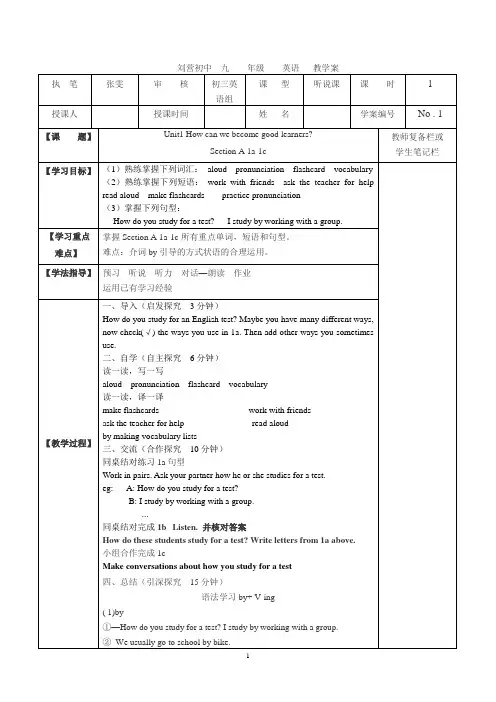
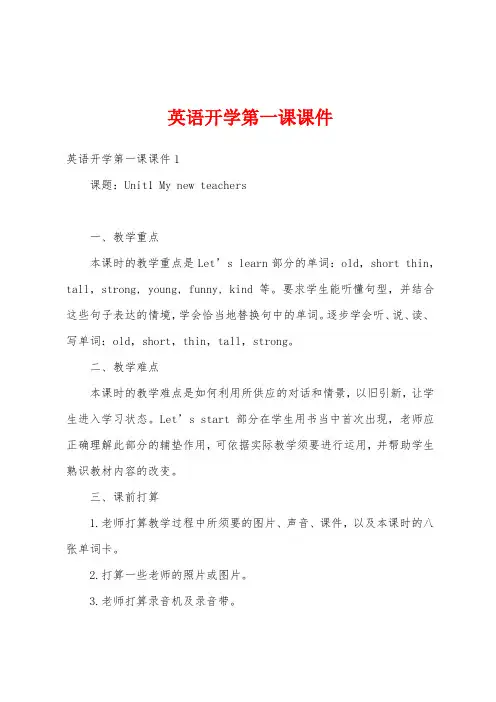
英语开学第一课课件英语开学第一课课件1课题:Unit1 My new teachers一、教学重点本课时的教学重点是Let’s learn部分的单词:old,short thin,tall,strong, young, funny, kind等。
要求学生能听懂句型,并结合这些句子表达的情境,学会恰当地替换句中的单词。
逐步学会听、说、读、写单词:old,short,thin,tall,strong。
二、教学难点本课时的教学难点是如何利用所供应的对话和情景,以旧引新,让学生进入学习状态。
Let’s start部分在学生用书当中首次出现,老师应正确理解此部分的辅垫作用,可依据实际教学须要进行运用,并帮助学生熟识教材内容的改变。
三、课前打算1.老师打算教学过程中所须要的图片、声音、课件,以及本课时的八张单词卡。
2.打算一些老师的照片或图片。
3.老师打算录音机及录音带。
四、教学过程1.Warm-up(热身)(l) 老师播放Let’s start下面歌谣的录音,让学生听歌谣猜单元话题,激发学生对新学期第一单元英语学习的爱好。
还可以运用四年级上册第三单元学过的句型:“I have a new friend. He’s tall. He’s strong, too.”并结合相关人物的图片,引导学生复习 strong, tall, short,thin等词,为本课时听、说、读、写这些单词做好打算。
(2)日常口语练习,内容可参考如下:T:Hello, everyone! Welcome back to school! Nice to see you!Ss: Nice to meet you!(3) 问学生几个问题,引出本课重点内容。
详细会话可参考如下:T:Hi,everyone!Nice to see you again.What grade are you in now?Ss:We’re in Grade 5.T:Do you like your new English books(new classroom, new teacher)?Ss:Yes!T: What are we going to talk about in Unit 1?Guess!What’s the topic of Unit 1?2. Presentation(新课呈现)(l)老师出示Let’s start部分图片,介绍说: Rabbit has many newteachers in her school. Do you have new teachers? 引导学生依据情景图的提示描述新老师。

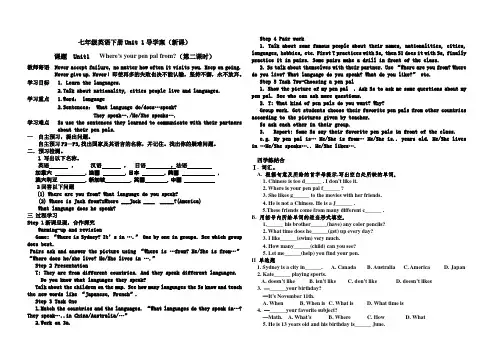
七年级英语下册Unit 1导学案(新课)课题 Unit1 Where’s your pen pal from?(第二课时)教师寄语 Never accept failure, no matter how often it visits you. Keep on going. Never give up. Never!即使再多的失败也决不能认输,坚持不懈,永不放弃。
学习目标 1. Learn the languages.2.Talk about nationality, cities people live and languages.学习重点 1.Word: language2.Sentences:What language do/does…speak?They speak…./He/She speaks….学习难点 Ss use the sentences they learned to communicate with their partners about their pen pals.一自主预习,提出问题。
自主预习P2—P3,找出国家及其语言的名称,并记住。
找出你的疑难问题。
二.预习检测。
1 写出以下名称。
英语,汉语,日语,法语加拿大,法国,日本,美国,澳大利亚,新加坡,英国,中国2回答以下问题(1) Where are you from? What language do you speak?(2) Where is Jack from?=Where ___Jack ____ _____?(America)What language does he speak?三过程学习Step 1新课呈现,合作探究Warming-up and revisionGame: “Where is Sydney? It’s in ….” One by o ne in groups. See which group does best.Pairs ask and answer the picture using “Where is …from? He/She is from…” “Where does he/she live? He/She lives in ….”Step 2 PresentationT: They are from different countries. And they speak different languages.Do you know what languages they speak?Talk about the children on the map. See how many languages the Ss know and teach the new words like “Japanese, French”.Step 3 Task One1.Match the countries and the languages. “What languages do they speak in…? Th ey speak…..in China/Australia/…”2.Work on 3a.Step 4 Pair work1. Talk about some famous people about their names, nationalities, cities, languages, hobbies, etc. First T practices with Ss, then S1 does it with Ss, finally practice it in pairs. Some pairs make a drill in front of the class.2. Ss talk about themselves with their partner. Use “Where are you from? Where do you live? What language do you speak? What do you like?” etc.Step 5 Task Two-Choosing a pen pal1. Show the picture of my pen pal . Ask Ss to ask me some questions about my pen pal. See who can ask more questions.2. T: What kind of pen pals do you want? Why?Group work. Get students choose their favorite pen pals from other countries according to the pictures given by teacher.Ss ask each other in their group.3. Report: Some Ss say their favorite pen pals in front of the class.e.g. My pen pal is… He/She is from… He/She is.. years old. He/She lives in …He/She speaks….. He/She likes….四学练结合Ⅰ. 词汇。
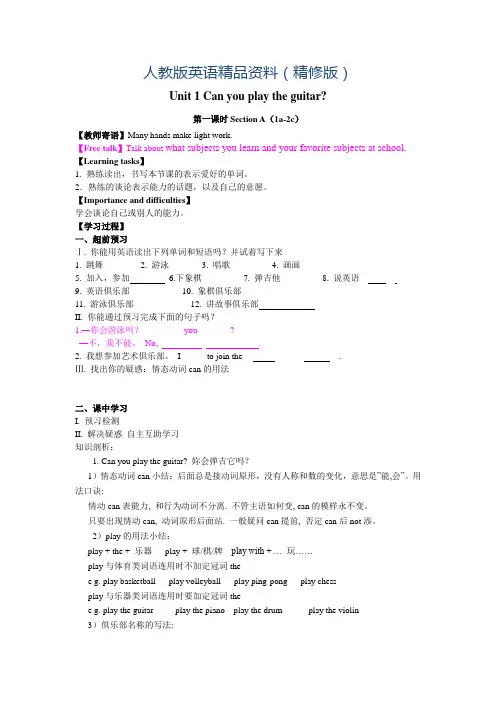
人教版英语精品资料(精修版)Unit 1 Can you play the guitar?第一课时Section A(1a-2c)【教师寄语】Many hands make light work.【Free talk】Talk about what subjects you learn and your favorite subjects at school.【Learning tasks】1.熟练读出,书写本节课的表示爱好的单词。
2.熟练的谈论表示能力的话题,以及自己的意愿。
【Importance and difficulties】学会谈论自己或别人的能力。
【学习过程】一、超前预习Ⅰ. 你能用英语读出下列单词和短语吗?并试着写下来1. 跳舞________2. 游泳_______3. 唱歌_________4. 画画_________5. 加入,参加6.下象棋_________7. 弹吉他_________8. 说英语__ __ _____9. 英语俱乐部___________10. 象棋俱乐部____________11. 游泳俱乐部_____________12. 讲故事俱乐部II. 你能通过预习完成下面的句子吗?1.—你会游泳吗?______ you _______?—不,我不能。
No, .2. 我想参加艺术俱乐部。
I _____ to join the __ ___ ___ __.Ⅲ. 找出你的疑惑:情态动词can的用法____________________________________________________________________________________________________________________________二、课中学习I. 预习检测II. 解决疑惑自主互助学习知识剖析:1. Can you play the guitar? 妳会弹吉它吗?1)情态动词can小结:后面总是接动词原形,没有人称和数的变化,意思是”能,会”。
![2012年人教版本七年级英语上册unit1导学案[1]](https://uimg.taocdn.com/361e5841af1ffc4ffe47ac54.webp)
Unit1 My name’s Gina. S ection A 1a—1c (1 课时)【学习目标】1)能正确听辨运用What's your name ?来询问他人的姓名和运用My name is…/ I'm …来介绍自己的语句。
并会使用形容词性物主代词。
2)能运用Hello, hi 等打招呼,并能掌握和运用一些打招呼语言,遇到适当的场景能准确应用。
3)学会见面后的客套用语Nice to meet you.4)学会几个英语名字Gina Mary Alan Jenny Jim .【重点、难点】1.正确运用What's your name ?来询问他人的姓名和My name is…/ I’m …来介绍自己的语句。
2.大量的英语人名。
3.形容词性物主代词my/your。
【导学指导】温故知新1.大声唱字母歌,复习26 个字母。
2.小组合作复习预备单元的人名、打招呼、物体、颜色等单词及相关句型。
3.学习新的人名、打招呼及自我介绍词语及句型。
自主互助学习一、试一试,看音标学单词(Page87)。
读写生词并熟记,看谁记得快。
1.我的2.名字3.是4.女士5.我6.是7.好的,令人愉快的8.遇见相逢9.你,你们10.什么11.你的,你们的12.喂13.嗨's = 15.I'm= 16.what's=二、通过预习SectionA1a-1c 之后,请快速翻译下列句子。
你叫什么名字?我的名字叫Jenny。
我是Gina。
见到你很高兴。
喂,Mary!我是Jim。
三、看1a 中的图片,写出图中物品的英语单词。
你能写出几个?尽可能的多写几个。
1.2.看图上的三个小对话,了解大意学习对话What's your name ? My name is . 使用学过的英语名字,练习对话。
3.(1)听力练习1b . (2)结对活动1c .4.学习形容词性物主代词。
物主代词(1)表示所有关系的代词叫物主代词。